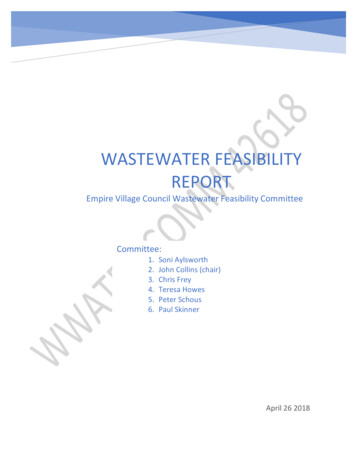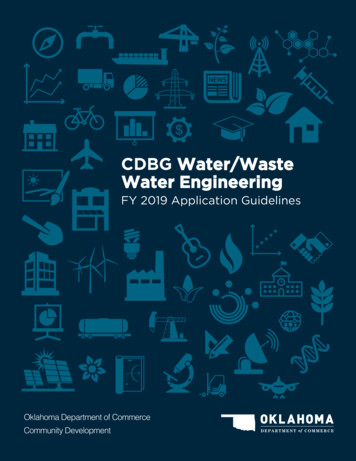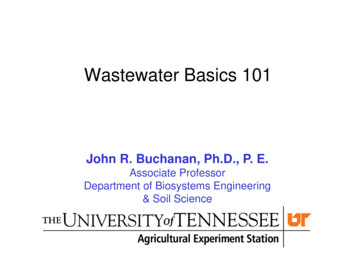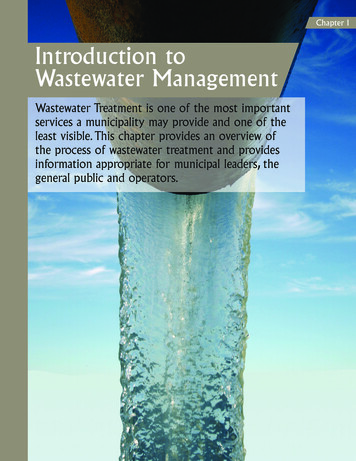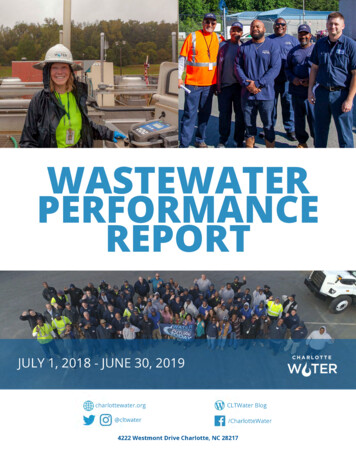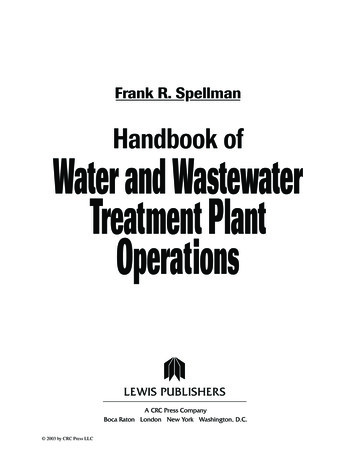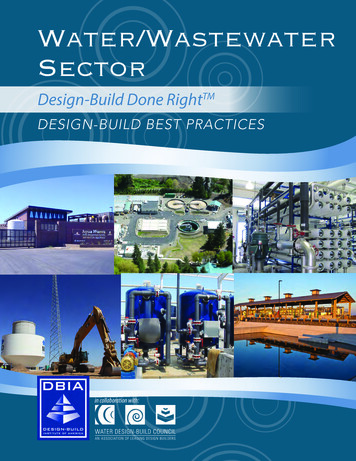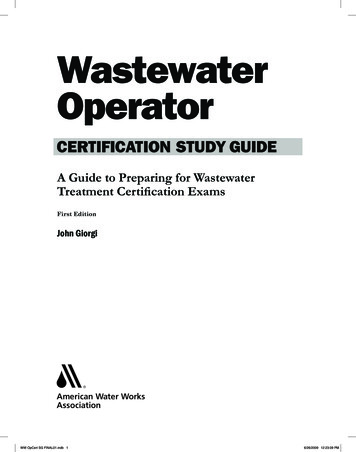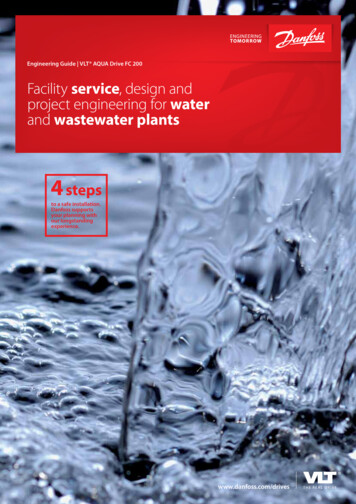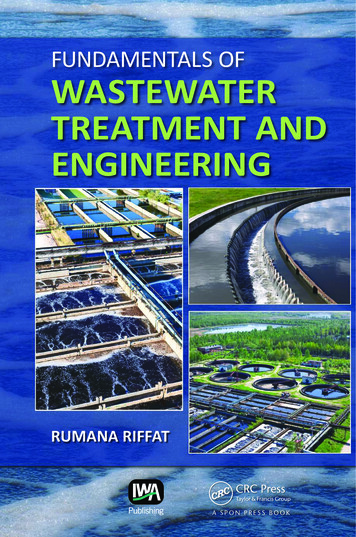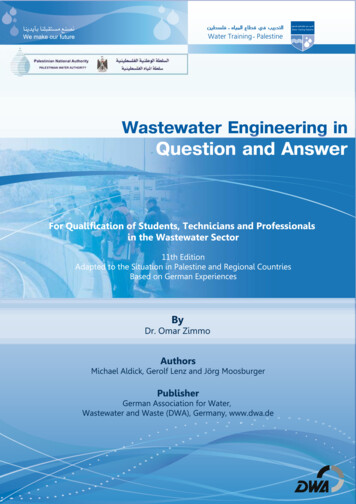
Transcription
ISBN 978-3-940173-71-3from 01.01.2007: ISBN 978-3-88721-193-6Publisher:German Association for Water, Wastewater and Waste (DWA)Germany, www.dwa.de F. Hirthammer Verlag GmbH, Raiffeisenallee 10,D-82041 Oberhaching/MünchenTel.: 49 (0) 89 323 33 60 Fax 49 (0) 89 324 17 28www.hirthhammerverlag.deAll rights reserved. It is not permitted to reproduce the book or parts thereof in any form withoutapproval of the publisher.
Foreword“Wastewater engineering in question and answer”This book is adapted from the titled book “Wastewater engineering in question and answer”, 10thedition published by the German Association for Water, Wastewater and Waste (DWA), to suite thewastewater situation in Palestine and other countries in the region. The adaptation and publicationof this new version comes within the scope of the German Technical Cooperation support (GTZ)to the Palestinian Water Authority (PWA) in managing and coordinating training in the PalestinianWater Sector.The revised 11th edition of the book “Wastewater Engineering in Question and Answer” aims atproviding knowledge and practical experience to professionals, trainers, university students andto enable technicians and vocational staff to carry out responsible tasks independently and to givemaster technicians increased competence in leadership and management. This English-languageedition covers the main areas of wastewater discharge, wastewater treatment, sludge treatment,sampling and analysis. It comprises two parts: a task part and a solution one, while the diversity ofthe wastewater engineering subjects is given the widest cover.The adaptation of the this book has been coordinated and discussed with the Wastewater TechnicianTraining Working Group representing a variety of Palestinian experts and stakeholders in thewastewater field. Without their support and commitment; it would have not been possible to coverthe widest spectrum of operational aspects of wastewater services in our region.We would like also to acknowledge the efforts of all those who have in a way or another contributedto the completion and production of this important work; not to mention all, the Palestinian WaterAuthority (PWA), Mr. Rudiger Heidebrecht of DWA who without his inspiring ideas this book wouldhave never seen the light. A word of thanks is also due to the water team and consultants of theGerman TC Water Programme in the Palestinian Territories for the financial support and the highstandard technical input they have provided resulting in timely and quality completion of the book.Finally, we dedicate this book to all Palestinian and regional experts who are thirsty for practical, butrelevant challenges in the operational aspects of the wastewater field.Shaddad Attili - PWANadim Mulhem - GTZIOmar Zimmo - BZU
Biography Dr. ZimmoOmar Rabah Zimmo was born on November 21st, 1958 in the city of Gaza-Palestine. In 1978, hegraduated from Palestine high school in Gaza, after which he enrolled in the Al-Mansoura Universityin Egypt. He obtained a B.Sc. degree in the civil engineering in 1982 with honours. In 1984 hewas awarded a scholarship by the AMIDEAST (USA) to study his MSc. degree in EnvironmentalEngineering in Tufts University, Boston, Massachusetts, USA. His thesis was on “Detection of groundwater contamination using ultra violet laser”. After graduation and from 1986 to date, he has been aninstructor in the civil engineering department at Birzeit University.In September 1997 he was awarded a scholarship from the Dutch government to study his PhD inthe UNESCO-IHE, Institute for Water Education, The Netherlands. His dissertation was on “Nitrogentransformations and removal mechanisms in algal and duckweed waste stabilisation ponds”. Inaddition to his lecturing activities at Birzeit University, since 1990, he has been responsible forthe successful training of more than 100 environmental specialists for wastewater engineeringin Palestine. He has for many years been engaged in most of the wastewater projects in theMediterranean countries.Contact :Birzeit UniversityP.O Box 14. West Bank-PalestineTel: 972 (02) 298 2108Fax: 972 (02) 298 2984E-mail: ozammo@birzeit.eduII
The AuthorsDipl.-Ing. (TU) Michael Aldick (born in 1944) comes from East Westphalia. He studied civilengineering in Karlsruhe. Since 1972 he has been active with the Ruhrverband (Ruhr Association)in Essen, inter alia as longstanding assistant to the Chairman of the Board of Management. In1978 he became lecturer for the ATV Wastewater Master Technician courses in Essen. In the90s he collaborated with both the production of a new master technician course concept and withthe production of DWA instructional documentation for female master technicians. Since 1993 hehas been member of the Specialist Committee “Wastewater Master Technician” and, since 1995,its spokesman. From 2003 to 2004, as specialist he saw through the amendment process of the[German] Wastewater Master Technician Ordinance. For his services to the training of operatingpersonnel in wastewater engineering facilities he received the golden DWA Badge (pin) of Honour.In addition, since 1985, he has been responsible for the successful training of more than 120environmental technicians and specialists for wastewater engineering at the Ruhrverband. Inaddition to his lecturing activities in the interdisciplinary training of operating personnel at BEW inEssen, he has for many years been engaged with the NRW Federal State Environment Office withinthe specialist examination committee. Together with Gerolf Lenz he took on the elaboration of thecollection of tasks of the part on wastewater engineering, Chapters 1 to 6, of the10th Edition.Dipl.-Ing (TH) Gerolf Lenz was born in 1945 in Altenberg/Erzgebirge. Following successful crafttraining as a mason he studied at the Technical College in Wuppertal and subsequently civilengineering at the RWTH Technical University in Aachen.From 1974 until his retirement in 2006, asHead of Division at the Wupperverband (Wupper Association), he was responsible for the operationof wastewater treatment works and, in recent years, active as Head of Staffing in the Board ofManagement.In 1985 he took over as spokesman of the DWA Specialist Committee “Specialists”. He is directorof DWA external courses in Nordrhein-Westfalen for the preparation of examinations of theenvironmental engineering occupation “Specialist for Wastewater Engineering”. As director andlecture of these external courses he has prepared more than 1,800 examinees for the examination.Furthermore, from 1998 to 2002 he collaborated as specialist in the amendment process of theenvironmental engineering occupations of the Federal German State of Nordrhein-Westfalen.Together with Michael Aldick he is responsible for the wastewater engineering part, Chapters 1 to 6of the 10th Edition.Jörg Moosburger (born in 1958).comes from Gelsenkirchen. Up until 1984 he worked as an electricianin the coal mining industry. On moving to the Lippeverband (Lippe Association) he was employedfirst in the mechanical sludge dewatering area, later in various fields of wastewater treatment. Asexternal environmental technician he passed the Wastewater Master Technician examination in1990 and in 2001 further trained as “Technical Business Economist CCI”. Since 1994 he has beenemployed as Master technician at the Dortmund Scharnhorst wastewater treatment plant.In 1997 he was appointed as member of the examination committee for wastewater master techniciansat the Federal State Environment Office NRW.In addition, since 1999, as lecturer he has instructedfuture specialists and master technicians in environmental occupations in the fields of electrical,measurement and control and wastewater engineering within the framework of interdisciplinarytraining and occupational further training. In 2003 he took over the technical direction of the DWAcourse for the preparation for the wastewater Master technician examination in Essen. In addition heis responsible for the DWA additional training for electro-technically qualified persons. He elaboratedthe electro-technical part, Chapter 7 of the collection of tasks of the10th Edition book.III
ForewordThe Biography Dr. ZimmoThe AuthorsIntroductionIIIIII1Tasks Section21. Types, yields and properties of wastewater42. Operation and maintenance of drainage systems2.1 Drainage systems2.2 Sewers and drains2.3 Pumps and pumping stations2.4 Sewer operation10101318243. Operation and maintenance of wastewater treatmen systems3.1 Flow charts of wastewater treatment systems3.2 Screen and sieve facilities3.3 Grit chambers and grease traps3.4 Primary settling tanks3.5 Biological wastewater treatment3.6 Activated sludge processes3.6.1 Aeration tanks (without nitrification)3.6.2 Aeration3.6.3 Secondary settling tanks3.7 Nitrogen removal3.8 Fixed bed processes3333374451566060657379864Sewage sludge treatment and utilisation of Sludge from WastewaterTreatment Facilities4.1 Flow diagrams of sewage sludge treatment facilities4.2 Types of sludge and sludge stablisation general4.3 Anaerobic sludge treatment (digestion)4.4 Gas production, processing and utilisation4.5 Conditioning, thickening, storage and sludge dewatering4.6 Utilisation, disposal of sludge and residues9393971001071131175. Sampling, measurement and examination ofwastewater and sludge5.1 Sampling5.2 Measurement and examinations119119122
Solutions Section1291. Types, yields and properties of wastewater1302. Operation and maintenance of drainage facilities1343. Operation and maintenance of wastewater treatment facilities1544. Sewage sludge treatment and utilisation ofwastes from wastewater facilities2005. Sampling, measurements and examination ofwastewater and sludge2206. Bibliography2297. Abbreviations for the list of formula2318. Formula232
IntroductionInPalestine, the existing water and wastewater/sanitation infrastructure suffers from inadequatelevel of skills in planning, designing, managing, operating and maintaining of the infrastructure toensure its sustainability. Furthermore, there is no coordinated effort on human resources developmentaimed to build the needed managerial and technical capacity among water and wastewater serviceproviders. So far, this sector lacks any needs-based capacity building and systematic trainingarrangements.The Palestinian Water Authority (PWA) is the official regulatory body within the Palestinian WaterSector responsible for water resource management and protection, as well as being in charge ofimplementing the water policies, as the Palestinian Water Law issued in 2002 specifies. PWA ismandated in the Water Law to oversee, plan and coordinate training of technical and professionalstaff at all levels in the water sector. Within this context, PWA has requested the German TechnicalCooperation (GTZ) support in managing and coordinating training in the Palestinian Water Sector.GTZ began offering their technical support to PWA since February 2004, through the TrainingCoordination Project which was integrated into the Human Resources-Sector Developmentcomponent II of the Water Programme in Palestine as of January 2006.GTZ is supporting PWA by setting up Training Coordination Units (TCUs) within PWA, appointingtechnical coordinators, mobilizing support from the German Association for Water, Wastewater andWaste (DWA), carrying out some pilot trainings, planning workshops and organizing study tours.Four Working Groups, each is chaired by a local expert working in the water sector, has beenestablished in the West Bank and Gaza; consisting of 8 to 10 members representing a varietyof stakeholders in the Palestinian Water sector to develop training policy, assess training needsand identify resources. A steering Committee to coach the results of the working groups has beenestablished.The main objective of the Human Resources- Sector Development Component II of the WaterProgramme in the Palestinian Territories is that PWA coordination of cooperation between donors,service providers and training providers for professional and technical education and training inthe water sector is improved; so that training will be carried out in a coordinated way which issystematic, demand-oriented and uses local, regional and international training resources costeffectively. This will contribute on the long run to improved delivery of water and wastewater servicesto the Palestinian population.The adaptation of “Wastewater Engineering in Question and Answer” comes as a step towardsproviding quality training material for targeted groups of trainers, students, and vocational staffworking in the wastewater field for the aim of enhancing their performance either in delivering orreceiving good quality of training feasible to implementation in Palestine and regional countries.
TasksSectionNote:With the programmed tasks only onesolution is correct
Types, yields and properties of wastewater1.Types, yields and properties of wastewaterWastewater is water which is changed in its properties through domestic, commercial,agricultural or other usage and that water flowing off together with this with dry weather(wastewater) as well as that water resulting from precipitation flowing off and collectedfrom the area of built-up and paved surfaces (precipitation water). Wastewater isdifferentiated according to type, yield and propertiesPart (A)Task 1)In general the wastewater flowing to a wastewater treatment plant is divided according to itssource into four wastewater types.Name these and give an example for each.Task 2)The yield of municipal wastewater corresponds essentially with the domestic consumption of freshwater.a) Give the average water consumption in countries like Palestine and Jordan in litres perinhabitant and day.b) Draw a diagram of the typical daily curve of the wastewater inflow to a wastewater treatmentplant with 50,000 PT[ y-axis: Q (m3/h); x-axis: time (h) ].Task 3)Give examples for the following characteristic parameters of municipal wastewater:1) General parameters.2) Group parameters.3) Individual substance parameters.4) Nutrient parameters.Task 4)Municipal wastewater is in part changed in its properties along its flow-path from its place of originto the wastewater treatment plant.Name the processes which can lead to changes in the properties of the wastewater along theflowpath.
Types, yields and properties of wastewaterTask 5)Protein as part of human nutrition contains nitrogen in the form of amino acids. Correspondinglyhuman metabolic products also consist of organic and inorganic nitrogen compounds.a) Which organic nitrogen compounds are excreted in large quantities with the urine by humans?b) On the flow-path from the place of origin to the wastewater treatment plant this organic nitrogencompound is split by enzymes into two inorganic compounds.Give the chemical reaction equation of this transformation.c) How is the transformation process and the corresponding enzyme designated?d) Inorganic nitrogen compounds flow extensively as ammonium and not as ammoniac intomunicipal wastewater treatment plants. Describe by what means the position of the balancedreactionNH3 H2O NH4 OHis shifted into ammonium.Task 6)Through the measurement of the electrical conductivity of the wastewater one can determine the:(a) oxygen content.(b) concentration of total ions.(c) acidity.(d) heavy metal content.(e) concentration of organic acids.Task 7)In the inflow to a municipal wastewater treatment plant the COD 1000 mg/l and the BOD5 500mg/l. From these figures it can be identified that one is concerned with:(a) industrial and domestic wastewater.(b) domestic wastewater with a high proportion of inorganic content substances from a dairy.(c) the typical properties of municipal wastewater.(d) a large amount of stormwater and a very little domestic wastewater.(e) a large amount of groundwater and precipitation water mixed together with 20 % domesticwastewater.
Types, yields and properties of wastewaterTask 8)Nitrogen is present in wastewater in various forms and compounds.Which of the listed “parameters” is a pure organic composition?a) Kjeldahl nitrogen (TKN)b) Amino acidc) Uric acid (C5 H4 N4 O3)d) Total nitrogen (total N)e) Nitrogen in total (Ntot)Task 9)As infiltration water one designates the inflow into the sewer system of:(a) damaging commercial/industrial wastewater.(b) unapproved connections.(c) water which runs in from roof and courtyard surfaces.(d) groundwater which penetrates through leaks and drains.(e) flushing water which is used for sewer cleaning.Task 10)A dry weather inflow (Qdw) is 100 litres/s. In this there is an infiltration component (Qinf)of 30 %.a) How many m3 is the infiltration water inflow per day?b) What influence has a higher infiltration water component on the operation of the wastewatertreatment plant?Task 11)The quantity of wastewater flowing from a combined system into a wastewater treatment plant with100,000 inhabitants can be taken from the following diagram.a) How big is the quantity of dry weather water?b) According to the diagram, how much water can the plant accept as a maximum?c) How large is the specific wastewater component (m3/(I x d)) of this wastewater treatment plant?d) Why does this value deviate from the mean specific water consumption (m3/(I x d))?
Types, yields and properties of 303540455055DaysDiag. 1./2:Inflowing water quantities curve
Types, yields and properties of wastewaterPart (B)Task 1)The hourly variations of the wastewater yield in large wastewater treatment works (with greaterwastewater quantities) in comparison with smaller wastewater treatment works (with smallerwastewater quantities) are:a) Largerb) Smaller.c) The same.d) Larger at night time only.e) Smaller during the daytime only.Task 2)Which type of wastewater contains stormwater?a) Infiltration water.b) Commercial/industrial wastewater.c) Combined wastewater.d) Domestic wastewater.e) Municipal wastewater.Task 3)Which sum parameter covers “all organic carbon compounds” of the wastewater?a) BOD5 - ATHb) BOD5c) CODd) DOCe) TOCTask 4)What is a typical property of domestic wastewater?a) high alkalinity.b) high acid content.c) high salt content.d) colloid content.e) content of substances which are difficult to degrade.
Types, yields and properties of wastewaterTask 5)Municipal wastewater contains on average 110 mg/l carbohydrates of which 75 % are undissolved.How many ml/litre carbon dioxide are formed in the biological stage at 20 C and 990 mbar and an85 % conversion of the dissolved carbohydrates according to the following reaction equation?C6H12O6 6 O2 6 CO2 6 H2O
Drainage systems2. Operation and maintenance of drainage systems2.1Drainage systemsFor the collection and discharge of wastewater, depending on localconditions, there are various systems such as separate, combined andmodified processes as well as pressure and vacuum systems. In additionto the discharge of precipitation water there is also the possibility ofpercolation.Task 1)Wastewater yielded in properties which are used both residentially and commercially is collectedand discharged in sewers.a) With wastewater treatment what do you understand under the terms- combined sewer system?- separate sewer system?b) Give the respective advantages for the combined and separate sewer systems.Task 2)In addition to combined and separate systems there are today also modified drainage systems.a) Explain the principle of the modified drainage systems.b) Complete the flowpaths with direction (arrows) in the following schematic diagram of a modifiedcombined system.10
Drainage systemsQsQsDomestic,commercialand industrialwastewaterCWsewerBody of waterPrecipitation waterrequiring treatmentStormwatertreatment Body of waterPrecipitation waternot requiringtreatmentWastewatertreatment plant Body of waterFlow from outsideareas, drainagewater, springs,wells etc.Utilisation,percolation,discharge Body of waterDiag. 2./1/: Schematic representation of drainage in the modified systemTask 3)Within the framework of domestic and private property drainage explain the following terms:a) Building/house drain.b) Down pipe.c) Connection.Task 4)With the separate system wastewater and stormwater sewers are arranged in the road crosssection at different heights.For what reasons is this arrangement decided?Task 5)In addition to the normal drainage processes (separate, combined and modified systems) pressureand vacuum processes are also applied for the disposal of wastewater.a) Give reasons for the employment of these processes.b) Name the essential elements of the pressure drainage system.11
Drainage systemsTask 6)In addition to discharge the disposal of precipitation water also takes place via percolation.a) Name the processes for percolation.b) Give the advantages of wastewater percolation compared with the discharge of precipitationwater.Task 7)In addition to the conventional discharge systems there are also exist “modified systems”. What doyou understand by these?a) Stormwater sewers have to be laid higher than wastewater sewers.b) Use of precipitation water for the flushing of toilets in households.c) Limitation of the density of residential development in order to reduce sealed surfaces.d) To percolate precipitation water not in need of treatment or to discharge it directly into a bodyof water.e) Setting up of stormwater collection barrels on private properties.Task 8)Which statement about the discharge of wastewater is false?a) Organic content substances are already converted biochemically with the discharge of thewastewater in the sewerb) With the combined system, as a rule retention systems are to found in the sewer network.c) With the separate system only part of the wastewater is treated biologically in the wastewatertreatment plant.d) With the modified system precipitation water not requiring treatment is discharged separatelyinto a body of water.e) With the combined system wastewater and stormwater are discharged in a common pipeline.12
Sewers and drains2.2Sewers and drainsSewers and drains serve for the collection and discharge of wastewaterPart (A)Task 1)Sewers and drains are made from various materials.a) Name the different materials used for sewers.b) To which physical and chemical stresses are these materials subjected?Task 2)With sewers and drains which factors have an influence on the amount of discharged water?Task 3)Name the most important requirements which are placed on sewer pipe connections.Task 4)Which tasks have manhole structures in a drainage system?Task 5)With sewer construction what do you understand under the terms “Length of reach [sewersection]”?a) Length of the back-up in the sewer.b) Covering of the sewer.c) Maximum length of the sewer.d) Useful life of a sewer.e) Separation between two manholes.13
Sewers and drainsTask 6)A 50 m long drainage sewer is represented on a drawing by a 10 cm line.Which scale has been selected?a) 1 : 1000b) 1 : 500c) 1 : 200d) 1 : 100e) 1 : 50Task 7)GradientLengthProfile1 : 25047.0 mDN 400Diag. 2.2./1:1 : 40065.0 mDN 4001 : 550bDN 600c55.0DN te the missing details a – c in the following value table of the longitudinal section of asewer:a) Altitude of invert.b) Length of reach.c) Gradient.1 : 25043.0 mDN 600Value table of a sewer longitudinal sectionTask 8)A sewer reach is 45.0 m long. The invert altitude at the start of the sewer reach is 317.65 m abovemean sea level (a.m.s.l.) and that at the end of the sewer section is 317.15 m a.m.s.l.Calculate the gradient of the sewer:a)in ‰.b)in 1 : x14
Sewers and drainsPart (B)Task 1)Sewers and intercepting sewers are laid in “free” fall (gradient) and are dimensioned according tothe continuity equation.a) What is the formula for the continuity equation?b) With sewers and intercepting sewers a minimum velocity must be maintained and, withcomplete filling, a maximum velocity may not be exceeded.Give the minimum velocity (m/s) and the maximum velocity (m/s) each with the respectivejustification.Task 2)With entry into sewers hazards for operating personnel can arise due to gases and vapours.a) Name the hazardous gases and vapours in sewer systems.b) For what substance is the sewer atmosphere to be tested before entry and visual inspection?Task 3)In addition to sewers and intercepting sewers pressure pipelines also serve for the transport ofwastewater.a) Give the parameters on which the size of the throughflow in the pipeline depends?b) With a pipeline, about what do the details of the nominal pressure, e.g. PN 10, make astatement?Task 4)The securing of pipeline trenches and construction pits is required with the laying of pipelines andwith the construction of manholes/special structuresa) Which possibilities exist for the securing of pipeline trenches and construction pits?b) From what depth of trench must safety measures be taken?15
Sewers and drainsTask 5)At what height is the back-up level in the public sewer system with domestic connections?a) 1.0 m under the surface of the road.b) 1.0 m above the surface of the road.c) At the height of the cellar floor.d) At the height of the road surface.e) Frost-free at a depth of 80cm in the ground.Task 6)With the selection of the sewer cross-section and profile what, in general is not taken intoaccount?a) The discharge.b) The gradient.c) The pipe material.d) The direction of flow.e) he road profile.Task 7)With what water pressure are sewers tested for watertightness after completion?a) At least 0.1 bar and maximum 0.5 bar.b) At least 1.0 bar and maximum 5.0 bar.c) At least 10.0 bar and maximum 25 bar.d) At least 5.0 bar and maximum 10.0 bar.e) According to details from the client.Task 8)Leaks in the sewer are found mainly:a) At the crown seam.b) In the invert drainage.c) At the pipe walls.d) At the pipe sockets.e) At the crown with small earth cover.16
Sewers and drainsTask 9)Water flows with a velocity of 1.2 m/s through a pipe with cross-section A 0.8 m2.a) How many m3 of water flow through the pipe per hour?b) Should the pipe cross-section be reduced or increased if a maximum of 2,000 m3/h are to flowthrough this at the same velocity?Task 10)The external diameter of a concrete pipe is 1,000 mm. The wall thickness of the concrete pipe is10 % of the external diameter.a) Calculate the internal diameter and the wall thickness of the pipe.b) Calculate the mass of the pipe (in t) with a length of 2.0 m and a density ρ (concrete) of 2.5kg/m3.17
Pumps and pumping stations2.3Pumps and pumping stationsIn wastewater engineering pumps with different impeller shapes areemployed depending on rate of delivery/delivery quantity, delivery head,distance and terrain shape (topographical conditions),Part (A)Task 1)In wastewater engineering pumps/pumping stations are often employed.a) Which types of pump are primarily employed in wastewater engineering?b) Which parts of a pump wear particularly quickly?Task 2)Pumps are dimensioned according to the delivery rate and/or motor drive output.a) What is the simplified basic formula for pumps?b) What does manometric head mean?Task 3)Which type of pump would you select respectively for the fields of application Nos. I to V listedbelow?1. Digested sludge from the sludge silo to the sludge dewatering plant (high pressures).2. Analyses pumps of an online measuring device in the laboratory (small quantities, low pressure).3. Phosphate material dosing at a dosing station (precise dosing).4. Feed pump for the classifier at the grit chamber (large inflow quantities).5. Primary sludge feeding to the digester (high pressures).18
Pumps and pumping stationsTask 4)If the rpm of a centrifugal pump are changed (e.g. through change of frequency), then some pumpand plant parameters also change. Give the parameters which can change in connection with this.Task 5)The total suction head of pumps is limited.a) How large is the theoretical total suction head at normal pressure?b) How large is the total suction head achievable in operation?Task 6)Two centrifugal pumps of the same size are operated in parallel.What happens to the delivery rate (Q) following failure of one pump?a) it is exactly the same as before.b) It is exactly 50 %.c) It is less than 50 %.d) It is more than 50 %.e) It is zero.Task 7)What does the Q-H characteristic diagram of a centrifugal pump show for a certain delivery rate?a) The appropriate current consumption.b) The appropriate pressure head.c) The corresponding economic efficiency.d) The appropriate total suction head.e) The corresponding efficiency.19
Pumps and pumping stationsTask 8)With the emptying of the pump sump the pump is no longer switched off automatically.What needs to be done?a) Switch off the pump and check the water level-dependent control.b) Let the pump continue to run.c) Slightly loosen the stuffing box.(d) Switch off the automatic operation and change to manual switching.(e) Switch of the pump facility completely.Task 9)To fill a 750 litre overhead tank at a height of 21.5 m with water a pump requires 18.5 minutes.How great is the efficiency of the facility if the power fed to the motor is 250 watts?Task 10)A reservoir with a volume of 2,400 m3 contents is emptied using three similar Pumps A, Band C (each pump respectively 100 m3/h capacity). At 0700h all three pumps are switched onsimultaneously. At 0930h (after 2.5 h) Pump A fails. Following successful repair Pump A wasswitched on again at 1300h.At what time is the reservoir tank emptied?20
Pumps and pumping stationsPart B)Task 1)With the centrifugal pump of a pumping station various operating situations occur (see tablebelow).Mark with a cross the respective correct solution from the three possible answers.A.Pump does not deliver.B.The delivery rate is too low.C.Pump runs un
“Wastewater engineering in question and answer” This book is adapted from the titled book “Wastewater engineering in question and answer”, 10th edition published by the German Association for Water, Wastewater and Waste (DWA), to suite the wastewater situation in Palestine and othe
